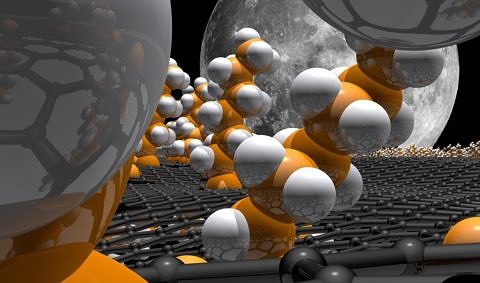FAU researchers solve one of the mysteries of solid-state physics

Mystery solved: electrical resistance in bilayer graphene grows in linear proportion to the magnetic field
Graphene – a one-atom-thick layer of common graphite – is full of surprises. In 2010, the Nobel Prize in Physics was awarded for the discovery of this material. Now, in their study of bilayer graphene, FAU researchers have made an exciting observation which provides the key to understanding a mysterious phenomenon in solid-state physics: the unusual behaviour of electrical resistance in magnetic fields. The researchers are now able to explain this. When two one-atom-thick layers are put together, minute wrinkles are formed on the atomic scale, giving the material a mosaic-like structure. The electric current in a magnetic field takes a winding path through this mosaic, which is what causes the unusual phenomenon. The researchers’ findings have recently been published in the renowned journal Nature Physics.*
When materials are exposed to a magnetic field, the electrical resistance reacts in the same way in almost all materials: as the strength of the magnetic field increases the resistance grows, and this growth is parabolic. However, in the literature there are occasional counterexamples from a wide range of material classes where, surprisingly, the growth of the resistance is not parabolic but linear – it is directly proportional to the growth of the magnetic field. The reason for this was a mystery to researchers for decades. As the phenomena is observed in different classes of materials it was thought to be down to a very general mechanism, eventually attributed to the granularity of the material. Although a highly simplified theoretical model describing the key aspects of the effect was developed in 2003, it cannot be directly proved through experiments and still leaves many questions unanswered. A working group led by Prof. Dr. Heiko B. Weber at FAU’s Chair of Applied Physics have now developed a model system that explains the mysterious phenomenon. Their key observation was that the magnetic resistance of bilayer graphene is linear – unlike that of single-layer graphene.
Surprising results
Bilayer graphene is a sheet of graphite that is just two atoms thick. Erlangen-based physicists mastered the art of producing high-quality bilayer graphene a number of years ago. Nevertheless, they were surprised to find that their measurements showed that from a magnetic field strength of around one tesla – approximately equivalent to that of a neodymium magnet – the magnetoresistance in bilayer graphene exhibited linear behaviour as the magnetic field strength grew. As they wanted to find out the highest magnetic field strength up to which this effect occurs, Weber and his team then went to the Dresden High Magnetic Field Laboratory at Helmholtz-Zentrum Dresden-Rossendorf to take measurements. To do so they exposed material samples to magnetic fields of up to 70 tesla – a strength bordering on the limits of what is technologically possible – for several milliseconds. Yet even under these extreme conditions the linear behaviour of the magnetoresistance in bilayer graphene continued – an effect that the FAU researchers described as robust.
The next challenge was to identify the reason for this behaviour. Granularity – which had previously been identified as a possible cause of linear resistance – did not seem to exist in the apparently homogeneous bilayer graphene. However, things were not as they first appeared, as observations carried out by Prof. Dr. Erdmann Spiecker’s working group in Erlangen under a transmission electron microscope showed that the bilayer form of graphene does indeed have a granular structure. This is because minute wrinkles, known as partial dislocations, form on the atomic scale in bilayer graphene, giving the material a mosaic-like structure.
Regarding the electrical properties of this mosaic Dr. Sam Shallcross at FAU’s Chair of Solid-State Physics developed a quantum mechanical model that calculates electron transition from one mosaic tile to another. Surprisingly, each dislocation creates a very effective barrier for the electrical current. Based on actual dislocations visible under a microscope the researchers were able to calculate the winding electrical pathways in the magnetic field – and discover the effect in question.
Graphene: an ideal model system
Graphene is a material that can be examined in minute detail under a microscope – it reads like an open book. These details are the key to answering the fundamental questions surrounding unusual phenomena.
In this case, bilayer graphene is the perfect model system for a mosaic-like conductor. Due to rapidly increasing interest in materials which are just a few atoms thick, the effects of linear magnetoresistance will become visible in more and more materials in the near future – and are now understood thanks to the experiments carried out by Prof. Weber and his team.
*DOI: 10.1038/nphys3368
Contact:
Prof. Dr. Heiko B. Weber
Phone: +49 9131 8528421
heiko.weber@physik.uni-erlangen.de